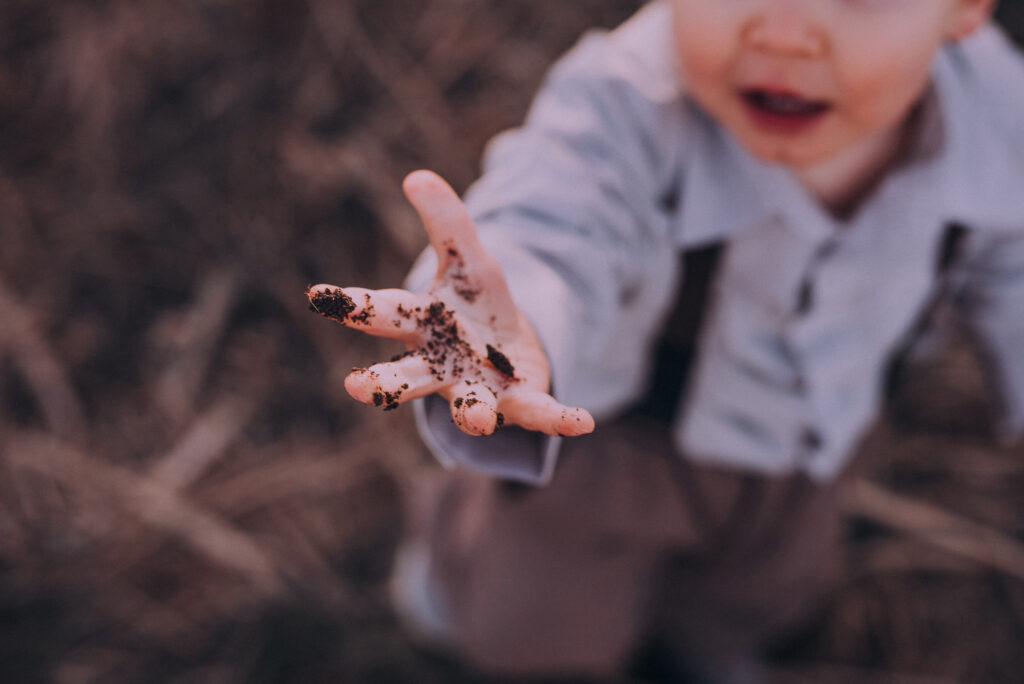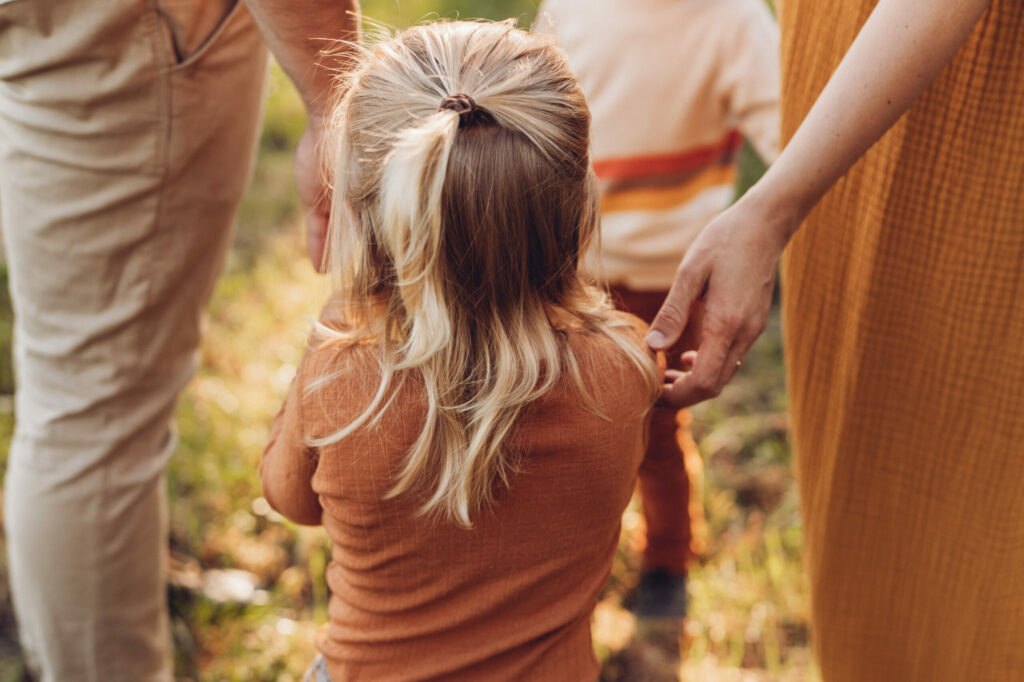
Your Triggers are your Teachers
When we find ourselves about to be tipped over the edge by our children’s behavior… it’s the


Respectful mama of 3
You might notice I didn’t title this article, “Quieting…” or “Silencing a Child‘s Emotional Storms.“ ⠀
You might be thinking to yourself, “I don’t like tantrums,” and continue your internet browsing elsewhere. But perhaps the title or these first two sentences peaked your interest and you’re curious about what braving a child’s emotional storms is all about. In that case, I’m happy you’re here!
So many of us spend our lives dismissing, running away from or being ashamed of our true emotions. We cover them up by lashing out, getting defensive, becoming offended, or by choosing to ignore them and redirecting our focus to something more pleasant. ⠀
Maybe you view yourself as someone without many ups and downs, and perhaps that is because you are particularly grounded, but there is a possibility that it is because you never learned to give your thoughts and feelings enough space to turn into waves for you to learn to ride out.
But why would we want to?
And how can we help our children learn to do the same?⠀
Here are nine tips that I hope give you a deeper understanding of you, as well your child, and equip you with practical tools to help you navigate whatever emotional storms may come your way.
Your baby screaming in your ear, crying through the darkest hours of the night. Your toddler wailing and refusing to eat when lunch is presented. Your child flailing on the ground and attempting to kick you while shouting “No! No! No!”
Many parents place unrealistic expectations on our small children. We believe that they should be capable of empathy. They should know how they’re effecting us! We sacrifice so much for them. They should be grateful! We love them and cater to their daily needs, going above and beyond because it makes us happy to see them smile. Shouldn’t they want to make us feel loved and appreciated?
To demand that love be reciprocated in a specific way, especially from someone whose brain and impulse control is still largely underdeveloped, is setting ourselves up for disappointment.
When we realize that our children communicate primarily through their behavior, not their words, we might begin to read, “I need your help!” between the lines of their tears and tantrums. We might find ourselves thankful to be viewed as the safe haven where our kids can “let it all out” instead of feeling disrespected or picked on because we’re the ones who always have to deal with them when they’re at their worst.
If we can remain “unruffled” in those moments, as Janet Lansbury puts it so beautifully, we provide our children with one less source of stress when their inner storms begin to brew. I’m not suggesting we send a cold message of “This doesn’t effect me because I don’t care.” I would never encourage anyone to give their child the cold shoulder when they are experiencing big emotions. My only suggestion is to remove any offence or thoughts implying that your child is “out to get you.” Providing someone with true support is very hard when you have no empathy for them.
So, next time you feel offended, pause and remember: Your daughter isn’t giving you a hard time — she’s having a hard time. Your son isn’t trying to make your life difficult — parts of his life feel difficult to process or accept.
Offering our understanding presence is providing our children with evidence of our unconditional love.
And what better message to send to someone who is struggling?
There’s a well-known saying that goes, “Don’t cry over spilled milk.” ⠀
But what if we re-worded it to say, “Don’t cry in response to feelings of failure, frustration,
inadequacy or loss.” Would we still be so quick to nod our heads in agreement? ⠀
Our children are still new here. Of this I am reminded again and again by the many tears that are shed by my 9-month-old when I close a door or come between her and something unsafe, or when my three-year-old comes running to me, sobbing over something she just dropped, spilled or broke.⠀
Yet, instead of immediately consoling my daughter with the fact that the item she’s now holding in two hands can be repaired or replaced, I first pause to remember that sinking feeling of regret. That stunned feeling of, “What have I done?” wishing I could just turn back time to ten seconds ago.
And instead of giggling at my baby, unintentionally ridiculing her in thinking she’s making a big deal out of nothing, I ponder the way it has felt for me throughout my life when doors have been shut in my face. How it feels to be rejected and left out. The frustration that overwhelms me when I’m not capable of overcoming the obstacles I face. ⠀
As adults, I find it to be an interesting realization that when minor annoyances trigger us, it’s usually the deeper messages they’re sending that push us over the edge.
Peering past the embarrassment of exploding over something as small as a cabinet door left open and figuring out what is actually bothering you can lead to conversations of much deeper reconciliation than a simple, “Sorry, that was stupid.”
So, the next time you find yourself dismissing your child’s tears, thinking to yourself how silly it is to be upset over something so minor or humorous, I want to encourage you to look a little deeper and remind yourself…
It’s not about the milk.
No parent enjoys seeing their child upset.
It pains us when our little ones are hurting, physically or due to the realities of this world, which can be quite harsh at times.
In their moments of upset, our children are masters in expressing themselves in big ways, often reaching volumes that cause us to feel like our very brains are being rattled.
Our kids are so gifted in the art of living only in the present moment. They can very easily enter a state of tunnel vision, focusing only on the fact that they do NOT want their diaper to be changed, it HURT when they just bumped their head or that they want a snack right NOW.
We tend to want to snap them out of it — for the sake of saving them from sitting in their own discomfort, but also so that we don’t have to sit in ours.
Instead of allowing the waves of emotion to build to their peak and crash over them, we often attempt to calm our little ones down before a full-blown tantrum ensues.
We resort to the short-term solutions of distracting and diverting their attention. We unknowingly use harmful tactics, sometimes even shaming our children into silence, just looking for the quickest way to resume with our day. Ultimately, we are dismissing our little ones’ big feelings, damaging their sense of self as well as their attention span, and missing out on the chance to journey through an uncomfortable feeling together.
I love the way Fred Rogers stated, “People have said, ‘Don’t cry’ to people for years and years, and all it has ever meant is, ‘I’m too uncomfortable when you show your feelings. Don’t cry.’ I’d rather have them say, ‘Go ahead and cry. I’m here to be with you.’”
Many people believe that validating emotions means agreeing with behavior. But what if comforting our children meant nothing but sitting with them, offering our loving presence and sending them the message, “You don’t need to pull yourself together in order for me to want to be with you.”
If we want to reach that place of true calm after the storm, we must be willing to provide our children with a safe place to release their tension. For them to arrive at their exhale, first, we must be willing to allow for some tears to flow.
One of my greater decisions in life has been to embrace the tensions that rise and fall as I breathe in and out each day.
For as long as I can remember, Jon Foreman has been one of my favorite musicians and artists. His poetic way of portraying our world has put words to my own thoughts and feelings, and also, introduced me to ideas that have shifted my way of thinking.
A few years ago, I stumbled across his TED Talk titled “Live Your Song.”
Between singing out his melodies, he spoke about the gift of life and what it might mean to view its composition as a song. Just as the strings of a guitar are stretched tight from one end of the instrument to the other, so are the polarizations we are confronted with every day. We might compare ourselves to guitar strings, stretched out between life and death.
Yet, we find it challenging to withstand tension, so we often run to one end or the other. Some even consider cutting the cord completely. But tension will only find its final resolve as we take our last breath and the drumming sound of our beating heart becomes only an echo of a memory.
To cut the cord of tension would be our end. So what can we do instead?
Music is nothing but arrangements of tension arising and resolving, quite like the ups and downs of life. To realize that dissonance is a natural occurrence might lead us to lean into the discomfort, not pull away.
Jon suggests that there, we begin to form melody. Dance upon the strings. Allow cadences to be formed within us as we find ourselves confronted with our own series of conflicts.
So, instead of sending our children the message that there’s no time to waste in finding resolve, let’s allow them to sit with us in their struggles, empowering them with our trust.
As a parent, this might mean choosing to create space for your child to truly feel those deep feelings of discomfort as you support them with your loving, patient presence, not simply make it to your mission to find a solution.
“I can see that you really miss your Papa,” I told my teary-eyed son last night as I put him to bed, without adding any sort of “but” or other consolation except, “I’m here.”
And really, that’s all we need to be — in the ups, and the downs — there for our children, truly there.
There’s no denying that as parents of young children, we are the ones who know them better than anyone else.
Yet, who of you would say that you’ve got your child all figured out?
I believe the day we say we’ve checked all the boxes or know all their ins and outs, is the day we take away their true freedom to become anything else than what our expectations and assumptions would have them be.
I personally find it to be wonderfully nerve-racking and exciting all the same to stand before my children again and again and let the mystery of who they are to me sink in.
There are thoughts and feelings inside of them that they may never share with anyone; a hidden world which must be uncovered to be discovered.
That realization hit me like a ton of bricks years ago, forever impacting my life and parenting.
I was in a hurry, rushing to get somewhere in seven minutes that took ten to walk to at a leisurely pace.
My firstborn was a little over one year old and just starting to expand his vocabulary beyond “yes,” “no,” “Mama,” and “Papa.”
Yet, when I put him in the stroller that morning, he did nothing but arch his back and scream. I, having only my agenda in mind, ignored him and thought to myself in frustration, “Deal with it.”
I thought he was protesting his stroller ride.⠀
After taking a few steps, his volume hadn’t changed, so I decided to pause and take a deep breath before going to meet him at eye level and ask kindly, “Hey, My Love, what’s going on?”
“Tght,” he said.
I was stunned. Sure enough, as I checked the straps, I could tell that the left one was digging into his shoulder and had already left a red mark behind.
I loosened them and asked him if that was better, to which he happily responded, “Good! Go!”
As we took off again, I thought to myself, “I wonder how often we get it wrong? How often do our assumptions hurt our relationships in foregoing the time it takes to simply meet at eye level and connect?”
I’ve decided then that I never want to pass up the opportunity to look my little ones in the eyes and ask with compassionate interest in my own, “What’s going on?”
We’re all on edge sometimes. For me, I know something is up when I find myself barking orders at my children instead of meeting them at eye level and having conversations with them, or when my brow furrows when my nine-month-old attempts to wriggle away from her diaper change.
In those moments, I can usually figure out where my tension is coming from when I pause to think about it. However, there are days when I either have no idea what is stealing my patience and joy… or I come up with a list so long, it feels overwhelming to even think about.
Sometimes, even the slightest change to our everyday life sends my toddler and pre- schooler into what I like to call, “adjustment mode.” In this state, anything can send them over the edge. The color of their spoon, their baby sister approaching what they’re playing with, the type of milk I choose to add to my cup of coffee…
Especially on days when one of my children is really struggling, I do my best to hear them out each time they’re upset. I hold space for them to release their feelings of frustration overwhelm. But after several days in a row have felt like an uphill battle, I like to offer ways to release some tension without confronting the issue at hand head on.
There’s a scene about emotional regulation in a movie about Mr. Rogers called, ‘A Beautiful Day in the Neighborhood‘, that I love:
Fred Rogers: There’s no normal life that is free from pain.
Lloyd Vogel: How do you deal with it?
Fred Rogers: Oh, well, there are many ways you can deal with your feelings without hurting yourself, or anybody else.
Lloyd Vogel: Yeah, like what?
Fred Rogers: Well, you can pound a lump of clay, or swim as fast as you can swim, or play the lowest keys on a piano all at the same time. [imitates hitting the piano keys]
Sometimes, I don’t know what’s bothering my child, or simply can’t free them from their pain that I’m the only one there for bed time, when their Papa is away for the evening.
When we sense an underlying tension in our home that’s like a knot we’re having trouble getting untangled, every now and then, we like to blast some music from an old record and have a spontaneous dance family dance party.
We have fun getting our wiggles out when someone gets wild and throw the couch cushions onto the floor. We spin when our minds feel heavy. Go on long walks along the river when it feels like we’re getting nowhere.
As important as it is to learn to articulate what’s going on in our inner worlds, sometimes, you gotta laugh until the heaviness lifts before you can put words to why it was there in the first place.
Our children are brilliant in communication. They are unhindered in crying out for help, love, and reassurance. They have no trouble letting us know that they are struggling, sending us that message LOUD and clear until we understand that…⠀
…they don’t want their loud, expressive voices to cause us to raise our own.
…it’s not their goal to upset us with their responses to situations that are upsetting to them.⠀
…they’re trying to find security and a safe place to hold onto, not attempting to push us away by digging their figurative fingernails under our skin.
I’ll never forget the way it felt like the world had slowed to a stop as I sat on the bed with two screaming children when my second child was a baby; one was in pain, the other in shock to see his mama lose her mind for a moment and even shed a few tears after he had just bitten his baby sister.
In my own feelings of failure and frustration with myself for being distracted in a moment that proved to be one in which my children would have needed my undivided attention, I snapped and aggressively responded to my then two-year-old’s aggressive behavior, not the underlying issue, which ultimately created yet another source of tension for my son to deal with.
When I reflect upon that situation and the rocky days that followed as we found our way back to a state of balance and harmony, it is so clear to me how much easier it is to venture through an emotional storm when the hand you’re holding feels strong and steady.
In their biggest meltdowns and most triggering behavior, I believe what a child wants to know most is, “When this world seems crazy and the unknowns feel overwhelming, can I can count on you to be there no matter what? When I’m pushing you away and being impossible, will you assure me that it is impossible for you to ever love me less?”
We don’t have to hop on and ride every wave of emotion that crashes over our children. In fact, I find it much kinder to offer empathy while patiently inviting them into our own calm, not giving way to the winds of fury.
Let us be their constant, their steady, their certain, their unwavering. Let us be their anchor in the waves.
Have you ever thought about how strange it is that in some families and cultures, the punishment for unwanted or aggressive behavior is aggressive? Think spanking. Harsh tones. Yelling. Grabbing. Hitting. “I’m gonna teach you a lesson.”
I might sound like a broken record by now, but I’ll say this again in different words: Behavior is never the true issue. It is the form of communication our children subconsciously resort to in attempts of dealing with their emotional storms. Behavior is a child trying to show us what’s going on on the inside — not just telling us something as straightforward as, “I feel like hurting my sister right now.”
So, if I notice that my toddler intends to cause my baby girl harm with her strong, little hands, I step in and lovingly take them in mine, hindering the pain she would have otherwise inflicted upon her baby sister. “I won’t let you hurt her.”, I remind her. In Janet Lansbury’s words, I let my three-year-old know that I’ve got her back by keeping her from acting upon her impulse.
Yet, should I be a moment too late, I remove her tight grip by stroking her hand and telling her I need her to be gentle.
Once she’s relaxed his fingers or I’ve helped her to do so, I take both children into my arms. Both usually crying. Both needing comfort and closeness.
I demonstrate tenderness and let my three-year-old soak it in alongside his sister, knowing that this is the easiest way for her to learn to be tender to others.
I’ve heard the phrase, “Monkey see, monkey do,” stated with a hopeless sort of embarrassment by parents since I was a little girl.
The tone you would hear in my voice when stating that fact, however, would be empowered to know that my life is my greatest tool in teaching.
Mindful of the possibility that my children could grow to reflect the values instilled within them by what my life, communication and own ways of emotional regulation portray, I am so motivated to do the inner work it takes to live a life that is conscious, honest, healthy and brave.
If one thing has become clear to me in regards to children and their emotional outbursts, it is this: What a child needs most when an emotional storm arises within them is our peaceful presence and empathetic understanding.
It is the security in knowing that our love for them is unwavering that gives them the feeling of safety they need to process the ups and downs they experience.
And when a child is overcome by their emotions, they are rarely able to return to a state of calm on their own. We must first de-escalate in order to co-regulate.
That usually includes many tears, lots of messes, countless repetitions of the word “No!” and shrill screams at a volume it’s hard to believe such a small person can attain. And honestly, I am not always in a state that allows for my children to ride out those waves. When I’m feeling agitated or overwhelmed, I tend to cut them short.
Unhealthy tactics reveal themselves in the way my toddler becomes instantly quiet, yet remains far from calm. Ultimately, I’m giving myself a tiny window of time that may seem like peace when I bring her expressions of upset to a sudden halt, but in reality, the storm continues to brew. The only difference is that my child is left alone in those feelings and learns from my response that they are not okay to feel.
So how can we position ourselves to be willing to dive head first into those intense outbursts and foster an environment where healthy emotional regulation can take place?
As Kristin Mariella (@respectfulmom) says, “The best way to keep yourself from getting pushed over the edge is to STAY AWAY from the edge.” “Self care is not a luxury,” she also once stated. “It is necessary!” ⠀
It makes so much sense to me.
As parents, we are willing to go to great lengths for our children. Our passion for them leads us to make sacrifices without batting an eye. We stay home. We spend money. We get out of bed. We offer our strength.
Now that there is a family dependent upon me in a multitude of ways, I find it more important than ever to continue to learn a language in which I am capable of communicating my needs.
I view it as imperative that I dedicate myself to tending to my own well-being, so I don’t end up attempting to run on an empty tank.
Being aware of my inner state and willing to let go of expectations, or reach out for help, helps me climb out of the state of overwhelm, and instead, model treating myself in the way I am worthy of.
So, let us look those emotional storms in the eye and ride out the waves until they crash upon the shore. For there is nothing like the peace that comes when the last tear has fallen with the last drop of rain, and the calm washes over in a more powerful and longer-lasting way than any of the previous waves.
Wholeheartedly,
P.S. You can find this post on Instagram here.

When we find ourselves about to be tipped over the edge by our children’s behavior… it’s the

When it comes to parenting, I feel like mothers and fathers are always hearing what they shouldn’t

Copyright Alyssa Schwarz © 2022 all rights reserved